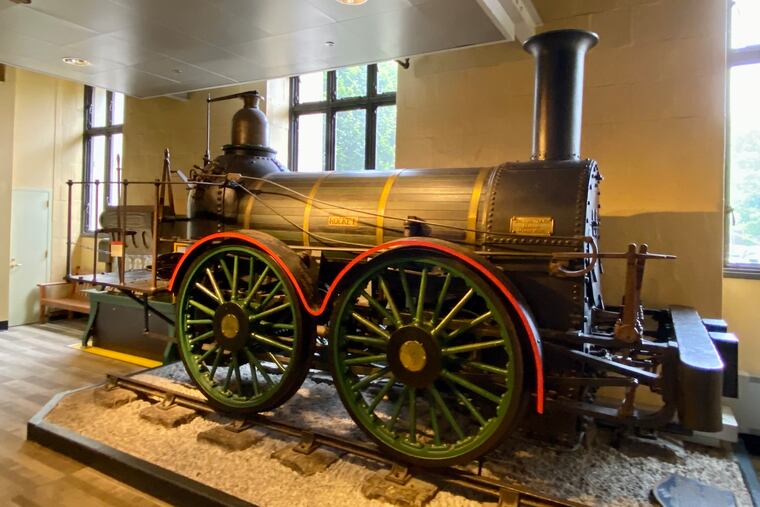The Franklin Institute’s antique Reading Railroad train has left Philly
Earlier this month, the Rocket train, the oldest surviving Reading Railroad locomotive, was transported to its new home, the Railroad Museum of Pennsylvania.

After 90 years, the Rocket was on the move again — this time on the back of a flatbed truck.
Earlier this month, the 185-year-old train — the oldest surviving Reading Railroad locomotive — was carefully hauled through a Franklin Institute gallery window and transported to its new home, the Railroad Museum of Pennsylvania in Lancaster. The move comes as the Franklin Institute reimagines its longtime “Train Factory” exhibit into a permanent two-story gallery of technological advancement. The “Treasures of the Franklin Institute Gallery,” scheduled to open sometime in 2024, will feature hundreds of rarely seen artifacts from the museum’s collections, including Benjamin Franklin’s glass armonica, drawings by the Wright brothers, and Thomas Edison’s light bulb.
Visitors at the upcoming exhibit will still be able to climb aboard and marvel over the museum’s more iconic — and larger — Baldwin 60000 steam locomotive. The Baldwin will remain dramatically displayed on a cutaway floor above the gallery. Sadly, space had to be made for the new collection, said Abby Bysshe, the museum’s chief experience and strategy officer.
“The decision to relocate the Rocket was a difficult one,” said Bysshe. “But this gives us the ability to tell new stories about the history of invention and innovation, while still retaining the Baldwin train. We will really have space to dig into the storytelling.”
Conrail, who owns the Rocket and had it on loan to Franklin Institute, quickly settled on the state’s railroad museum for the train’s new home.
“It’s an important piece of the state’s railroad history that belongs in Pennsylvania,” said Jocelyn Hill, a Conrail spokesperson.
One of eight early English-made locomotives purchased by the Philadelphia & Reading Railway, the Rocket had long been on the Railroad Museum of Pennsylvania’s wish list, said its executive director Patrick Morrison.
“Our mission is to talk about the history of railroading in Pennsylvania and the Rocket obviously fits right into that story,” he said.
After all, this isn’t the Rocket’s first journey.
It arrived at the Spruce Street wharf from England in March 1838, was carried by smaller boats on the Schuylkill Canal to Reading, then hauled by horses to the Reading-Pottstown terminus.
In the early 19th century, England was still leading in railroad technology, Morrison said, though U.S. companies were soon to catch up. With a boiler that could generate 25 horsepower, the Rocket could race up to 35 mph.
“Back then, when horses were galloping at 10 mph, that was pretty fast,” Morrison said.
The Rocket worked the Reading line for 40 years, racking up 310,164 miles, hauling passenger cars and equipment. By 1879, when newer locomotives could travel twice as fast, the Rocket was retired to the exhibition circuit. It appeared at two World’s Fairs, before arriving at the Franklin Institute in 1933.
Both the 17-foot Rocket, and the Baldwin train, had been built into the Franklin Institute’s building, Bysshe said. Only the Rocket could fit out the window. It took engineers and crane operators three days to maneuver the 17,000-pound train out the window.
“It wasn’t easy,” Bysshe said.
For now, the Rocket sits in an offsite location, as the Railroad Museum of Pennsylvania readies to unveil it at an eventual exhibition later this year, said Morrison.
“We are thrilled to be the next chapter of the Rocket,” he said.